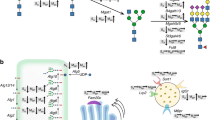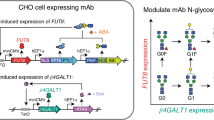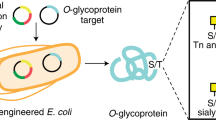Abstract
We have engineered two Chinese hamster ovary cell lines secreting different recombinant glycoproteins to express high levels of human β1,4-galactosyltransferase (GT, E.C. 2.4.1.38) and/or α2,3-sialyltransferase (ST, E.C. 2.4.99.6). N-linked oligosaccharide structures synthesized by cells overexpressing the glycosyltransferases showed greater homogeneity compared with control cell lines. When GT was overexpressed, oligosaccharides terminating with GlcNAc were significantly reduced compared with controls, whereas overexpression of ST resulted in sialylation of ≥90% of available branches. As expected, GT overexpression resulted in reduction of oligosaccharides terminating with GlcNAc, whereas overexpression of ST resulted in sialylation of ≥90% of available branches. The more highly sialylated glycoproteins had a significantly longer mean residence time in a rabbit model of pharmacokinetics. These experiments demonstrate the feasibility of genetically engineering cell lines to produce therapeutics with desired glycosylation patterns.
This is a preview of subscription content, access via your institution
Access options
Subscribe to this journal
Receive 12 print issues and online access
$209.00 per year
only $17.42 per issue
Buy this article
- Purchase on Springer Link
- Instant access to full article PDF
Prices may be subject to local taxes which are calculated during checkout





Similar content being viewed by others
References
Goochee, C.F., Gramer M.J., Andersen, D.C., Bahr, J.C. & Rasmussen, J.R. in Frontiers in bioprocessing II (eds Todd, P., Sikdar, S.K. & Bier, M.) 198–240 (American Chemical Society, Washington DC; 1992).
Ashwell, G. & Hartford, J. Carbohydrate specific receptors of the liver. Annu. Rev. Biochem. 51, 531–554 (1982).
Jenkins, N. & Curling, E.M.A. Glycosylation of recombinant proteins: problems and prospects. Enzyme Microb. Technol. 16, 354–364 (1994).
Andersen, D. & Goochee, C.F. The effect of cell culture conditions on the oligosaccharide structures of recombinant glycoproteins. Curr. Opin. Biotechnol. 5, 546–549 (1994).
Ashkenazi, A. et al. Protection against endotoxic shock by a tumor necrosis factor receptor immunoadhesin. Proc. Natl. Acad. Sci. USA 88, 10535–10539 (1991).
Keyt, B.A. et al. A faster and more potent form of tissue plasminogen activator. Proc. Natl. Acad. Sci. USA 91, 3670–3674 (1994).
Varki, A. Biological roles of oligosaccharides: all of the theories are correct. Glycobiology 3, 97–130 (1993).
Fukuda, M.N., Sasaki, H., Lopez, L. & Fukada, M. Survival of recombinant erythropoietin in the circulation: the role of carbohydrates. Blood 73, 84–89 (1989).
Wasley, L.C. et al. The importance of N- and O-linked oligosaccharides for the biosynthesis and in vitro and in vivo biologic activities of erythropoietin. Blood 77, 2624–2632 (1991).
Lee, Y.C. et al. Binding of synthetic oligosaccharides to the hepatic Gal/GalNAc lectin: dependence on fine structural features. J. Biol. Chem. 258, 199–202 (1983).
Jeffries, R. & Lund, J. Antibody engineering (Chemical Immunology), Vol. 65 (ed. Capra, J.D.) 111–128 (Karger Press, Basel, Switzerland; 1996).
Liu, D.T.-Y. Glycoprotein pharmaceuticals: scientific and regulatory considerations, and the US Orphan Drug Act. Trends Biotechnol. 10, 114–120 (1992).
Curling, E.M. et al. Recombinant human interferon-γ. Differences in glycosylation and proteolytic processing lead to heterogeneity in batch culture. Biochem. J. 272, 333–337 (1990).
Gramer, M.J. & Goochee, C.F. Glycosidase activities in Chinese hamster ovary cell lysate and cell culture supernatant. Biotechnol. Prog. 9, 366–373 (1993).
Paulson, J.C., Weinstein, J. & Schauer, A. Tissue specific expression of sialyltransferases. J. Biol. Chem. 264, 10931–10934 (1989).
Wen, D.X., Svensson, E.C. & Paulson, J.C. Tissue-specific alternative splicing of the βgalactoside α2,6-sialyltransferase gene. J. Biol. Chem. 267, 2512–2518 (1992).
Lee, U.E., Roth, J. & Paulsen, J.C. Alteration of terminal glycosylation sequences on N-linked oligosaccharides of Chinese hamster ovary cells by expression of β-galactoside α2,6-sialyltransferase. J. Biol. Chem. 164, 13848–13855 (1989).
Grabenhorst, E., Hoffmann, A., Nimtz, M., Zettmeissl, G. & Conradt H.S. Construction of stable BHK-21 cells co-expressing human secretory glycoproteins and human Gal(β1-4) GlcNAc-r α2,6-sialyltransferase. α2,6-linked NeuAc is preferentially attached to the Gal(β-1-4)GlcNAc(β-1-2)Man(α-1,3)-branch of diantennary oligosaccharides from secreted recombinant βtrace protein. Eur. J. Biochem. 232, 718–725 (1995).
Minch, S.L., Kallio, P.T. & Bailey, J.E. Tissue plasminogen activator co-expressed in Chinese hamster ovary cells with α-2,6-sialyltransferase contains NeuAc-α(2,6)Gal-β(1,4)GlcNAc linkages. Biotechnol. Prog. 11, 348–351 (1995).
Monaco, L. et al. Genetic engineering of α2,6 sialyltransferase in recombinant CHO cells and its effect on the sialylation of recombinant interferon-γ. Cytotechnology 22, 197–203 (1996).
Kitagawa, H. & Paulson, J.C. Cloning and expression of human Gal beta 1,3(4)GlcNAc alpha 2,3-sialyltransferase. Biochem. Biophys. Res. Commun. 194, 375–382 (1993).
Masri, K.A., Appert, H.E. & Fukuda, M.N. Identification of the full-length coding sequence for human galactosyltransferase (βN-acetyl-glucosaminide: β-1,4-galactosyltransferase) Biochem. Biophys. Res. Commun. 157, 657–663 (1988).
Lucas, B.K. et al. High level production of recombinant proteins in CHO cells using a dicistronic DHFR intron expression vector. Nucleic Acids Res. 24, 1774–1779 (1996).
Hilberg, F., Stocking, C., Ostertag, W. & Grez, M. Functional analysis of a retroviral host-range mutant: altered long terminal repeat sequences allow expression in embryonal carcinoma cells. Proc. Natl. Acad. Sci. USA 84, 5232–5236 (1987).
Anumula, K.R. Rapid quantitative determination of sialic acids in glycoproteins by high-performance liquid chromatography with a sensitive fluorescence detection. Anal.Biochem. 230, 24–30 (1995).
Papac, D.I., Briggs, J.B., Chin, E.T. & Jones, A.J.S. A high-throughput microscale method to release N-linked oligosaccharides from glycoproteins for matrix-assisted laser desorption/ionization time-of-flight mass spectrometric analysis. Glycobiology 8, 445–454 (1998).
Statistical Consultants PCNONLIN and NONLIN84: Software for the statistical analysis of non-linear models. The Amer. Stat. 40, 52–60 (1986).
Acknowledgements
The authors would like to acknowledge and thank Mary Sliwkowski, Thomas Warner, and Thomas Ryll of the Analytical Chemistry and Cell Culture & Fermentation Research and Development Departments, Genentech, Inc., for their insightful discussions and helpful comments in the planning of these studies and the preparation of this manuscript.
Author information
Authors and Affiliations
Corresponding author
Rights and permissions
About this article
Cite this article
Weikert, S., Papac, D., Briggs, J. et al. Engineering Chinese hamster ovary cells to maximize sialic acid content of recombinant glycoproteins. Nat Biotechnol 17, 1116–1121 (1999). https://doi.org/10.1038/15104
Received:
Accepted:
Issue Date:
DOI: https://doi.org/10.1038/15104
This article is cited by
-
Application of Genetic Engineering in Biotherapeutics Development
Journal of Pharmaceutical Innovation (2020)
-
Inhibition of poly-LacNAc biosynthesis with release of CMP-Neu5Ac feedback inhibition increases the sialylation of recombinant EPO produced in CHO cells
Scientific Reports (2018)
-
Sialic acid linkage differentiation of glycopeptides using capillary electrophoresis – electrospray ionization – mass spectrometry
Scientific Reports (2017)
-
Enhancing the sialylation of recombinant EPO produced in CHO cells via the inhibition of glycosphingolipid biosynthesis
Scientific Reports (2017)



